OAXACA CITY SURROUNDINGS
Tourism in OAXACA CITY SURROUNDINGS
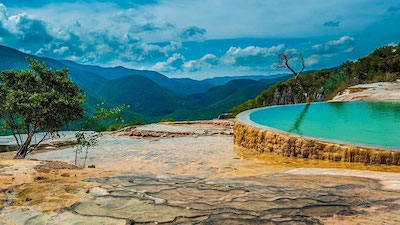
Oaxaca is a destination that offers a great variety of attractions and tourist charms which leave anyone surprised. When arriving in the city of Oaxaca, the most common is to visit the historic center, the Santo Domingo Temple, the Macedonio Tourist Walk, the gastronomic delights in the Benito Juárez market, the Basilica de la Soledad, among other attractions. And one of the places that you cannot miss is the Monte Alban archaeological zone, which is approximately 30 minutes by car from the historic center.
However, there are other places that are also worth knowing and are in the surroundings of the city. For this reason we recommend the following tourist routes.
Map of OAXACA CITY SURROUNDINGS
Route to Mitla
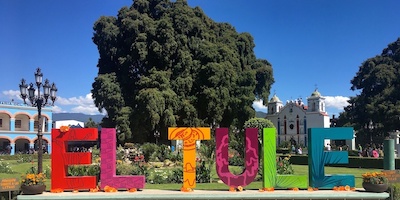
Santa María del Tule
Here you can find one of Oaxaca’s natural wonders, the massive 2000-year-old Cyprus tree “El Tule”. It is about 630 tons, 120 feet high and 144 feet around the trunk, the widest girth in the world. Make sure you get a child tour guide to show you the innumerable images in the trunk. It is located in the atrium of the church of Santa María de la Asunción, a Baroque- style church built in the18th century.
Tlacochahuaya
A religious, historical complex built by the Dominicans in the 16th century. The temple features a Baroque-style façade. But Tlacochahuaya is renowned for its beautiful Plateresque altars and especially for the painting of San Jeronimo by native artist Juan de Arrue. The murals decorating the walls were painted with cochineal seedling. Make a point of seeing the beautifully painted baroque organ in the choir loft.
Dainzú
This is a small archaeological site but very important historically. It dates as far back as 600 BC. It seems possible that the site was occupied some centuries before the foundation of Monte Albán. Here you’ll find some carvings that may remind you of the Dancers’ Gallery at Monte Albán; these, however, depict ball players in action with balls in their hands and dressed in fine outfits. The most spectacular sights are the well-restored ball court and the Tumba del Jaguar (Tomb of the Jaguar), with the head of a jaguar perched above the door.
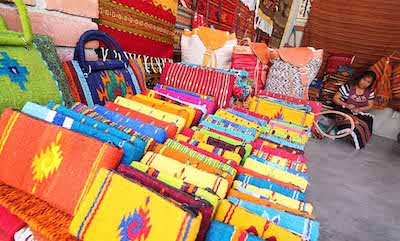
Teotitlán del Valle
Weaving tradition in Teotitlán dates back to Pre-Hispanic times. For centuries the families of the Zapotec weavers of Teotitlán have handed down the weaving tradition to their children. Century-old recipes are still used in the production of the natural dyes, which are obtained from marigold petals, añil, pomegranate zest, cochineal bug, seedpods, moss and pecan.
You will find brightly colored rugs, some with native indigenous motifs and other with modern designs such as reproductions of famous artists like Tamayo, Frida Kahlo, Miró, Matisse, Toledo and Picaso. The town has more than 100 workshops showcasing a large selection of handmade products, including rugs, wall hangings, handbags, pillow covers, jackets, ponchos and dresses.
There is a small community museum with an interesting exhibit of Pre-Hispanic objects and diverse objects related with the manufacture of textiles. The Preciosa Sangre de Cristo Church is well worth a visit. Its construction began in 1581 and was concluded in 1758. There are pre-Zapotec motifs in the walls since early friars used pre-Hispanic stones to build the church.
On the side of the church is a small archeological area. Near to Teotitlán is El Pichacho Peak, considered to be sacred, and its peaks offers a panoramic view of the Tlacolula Valley. And the Piedra Azul Dam a perfect place for bird watching.
Lambityeco
Evidence suggests that Lambityeco was first occupied about 600 B.C. Its peak was between 700 A.D. and 750 A.D. Lambityeco was originally a major trade center. It is confirmed that this city was a salt production center and that it provided up to 90% of the salt consumed in the valley between 600 and 700 AD.
The salt was extracted from dirt named “tequezquite” located in the southern part of the site. The archaeological zone comprises about 197 mounds but most of them are covered by weed. It is notable for the extraordinary artistic quality shown in the various urns, engraved bones and mural paintings in tombs. The two main structures at Lambityeco are Mound 190 and Mound 195.
The first one is an elite residence with the entrance flanked by two imposing Cocijo (the Zapotec rain god) masks wearing an impressive headdress.
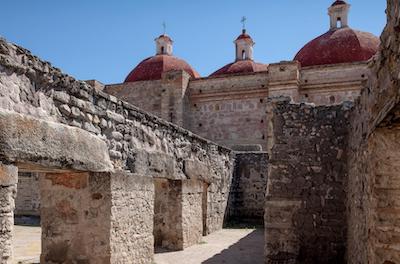
Santa Ana del Valle
A Zapotec community that has preserved its native language and traditions. There are weavers who produce beautiful woolen rugs, woven in the traditional way and dyed with natural colors. The small, but beautiful, 18th century temple has a Baroque altarpiece and interesting oil paintings.
In the town plaza is the Shan-Dany Community Museum with four small exhibits, focusing on archaeology, the Mexican Revolution, the village’s textiles, and the “Danza de la Pluma” (Feather Dance), where the dancers reenact the Spanish conquest. Open daily from 10:00 to 14:00 and from 15:00 to 18:00 hrs.
Tlacolula
On Sundays, don’t miss the market in Tlacolula, an exquisite extravaganza of flavors, aromas and unmatched color with a strong indigenous character, where women dressed in traditional native garb come down from their hillside villages to buy and sell all manner of products. The Church of “La Asunción de Nuestra Señora”, worth a visit. The parish was founded as a Dominican mission in the mid 16th century. Inside is the Baroque chapel dedicated to a crucifix called the Señor de Tlacolula, one of the most admirable jewels of Mexican baroque art.
Yagul
A former city-state associated with the Zapotec culture. Evidence shows that Yagul flourished as an urban center after the downfall of Monte Albán (800 years A.D.). The site is set around a hill, and can be divided into three principal areas: The first is the fortress, located atop the cliffs, it has a breathtaking view over the whole Tlacolula Valley.
The second, the Ceremonial center is an enormous man-made platform, with a number of large patios bordered by monumental architecture. And the third is the residential area. The most interesting features in the site are the Ball court, the largest in the Valley of Oaxaca, and the Palace of the Six Patios, a labyrinthine structure formed of an intricate complex of passageways reserved for the ruler or rulers of the city. Open Monday to Sunday from 9:00 to 17:00 hrs.
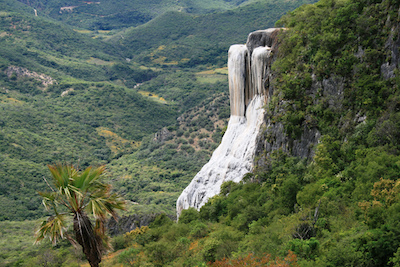
Mitla
The name is derived from the Nahuatl and means “place of the dead”. Mitla was the main religious center, the residence of the ecclesiastical power. This site was at its peak between 950 and 1521 A.D. It is one of the architectural wonders of Mexico, is unique among Mesoamerican sites because the elaborate and intricate mosaic fretwork and geometric designs that cover tombs, panels, and even entire walls.
These mosaics are made with small, finely cut and polished stone pieces, which have been fitted together without the use of mortar. There are five groups of buildings with a fence of cactus plants surrounding much of it. The five groups of constructions are called the South Group, the Adobe Group, the Arroyo Group, the Columns or Palace Group and the Church or North Group.
The first two have been classified as ceremonial centers with central plazas surrounded by mound structures, and the other three have been classified as palaces with rooms surrounding square courtyards. In the 17th century the Church of San Pablo, was built on top of part of the ruins using some of the stones of the old Zapotec palaces.
Hierve el Agua (Spanish for “the water boils”)
It is believed to have been a sacred place of the ancient Zapotec. This magical beauty features waterfalls, which seem to be melted crystal going down the mountains. There are two rock cliffs, one reaching down twelve meters and the other reaching down thirty meters. These formations are created by fresh water springs, whose water is over saturated with calcium carbonate and other minerals.
There is a natural platform with four springs and pools in which visitors can swim in this thermal waters with breath-taking landscapes. Water temperature fluctuates between 71 and 77ºF. There are bathrooms, dressing rooms, palapas (thatch-roofed, umbrella-shaped shelters), small eating facilities, and cabins to spend the night.
Route Monte Alban-Zaachila
Atzompa
This town has been a major producer of pottery since the Monte Alban period. If you’re shopping for the glazed-green pottery, this is the right place. In the main plaza there is the “Casa del Artesano” (House of the Craftsman) where you can learn more about this one of a kind pottery. In 2012 was inaugurated the archaeological site called Atzompa Monumental Complex, located atop the Bonete Hill.
The town was founded between as a satellite city to Monte Alban and was inhabited from 250 to 900 A.D. There are important structures like the Casa de Oriental (East House) and Casa de Altares (House of the Altars). However, the main find has been a 45-meter-long Mesoamerican ball court with two smaller courts next to it.
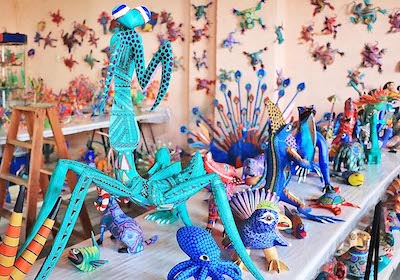
Arrazola
In this place, artisans produce fantastic wooden animals and creatures, made from copal wood. These beautiful handicrafts are exhibited and sold in the artisans’ own homes.
Cuilapam de Guerrero
Majestic Dominican complex from the 16th century. Its main attractions are the unfinished Open Chapel, the church and the Ex-convent. The church has naves with lofty arches, large stone columns, and many frescoes. General Vicente Guerrero, military hero of Mexico’s wars of independence, was shot here. Open daily from 10:00 to 18:00 hrs.
Zaachila
The site flourished from 1100-1521 AD. It was the last Zapotec capital but there is evidence that in the late urban era, when the Spaniards arrived, the Mixtecs had taken over. The archaeological zone has been partially excavated and includes a large man-made pyramid and a series of mounds with tombs. The Tomb 1 and Tomb 2 are the most outstanding.
Tomb 1 is decorated with feline heads and stucco figures with representations of owls, a human figure covered by a tortoise shell and serpent headdress. Tomb 2 contained rich offerings, including gold and jewelry. The site is in the middle of the modern town of Zaachila. Open daily from 8 a.m. – 5 p.m.
The tianguis and markets are a tradition dating back to pre- Hispanic times, and Zaachila is known for its Thursday Tianguis Market, it takes place between the central park and the church. Colorful stands are set up with the most traditional crafts and food from this area peanuts, radishes and regional fruits. Zaachila has considerable cultural wealth with native music, dance, and gastronomy; you may enjoy the culinary variety of Oaxaca in the one of the many traditional restaurants found in town.
Monte Alban
Ancient capital of the Zapotecs, it was subsequently occupied by the Mixtecs prior to the arrival of the Spaniards. It has been inscribed on the World Heritage List.
During its maximum splendor, Monte Alban extended 6.5 square kms and had an approximate population of 40,000 inhabitants. The civic-ceremonial center is situated atop an artificially-leveled ridge, which with an elevation of about 1,940 m (6,400 ft.) above the seas level. The Main Plaza is delimited by large platforms, temples, elite residences, and ball courts.
One characteristic of the site is the large number of carved stone monuments one encounters throughout the plaza, the so-called “Danzantes” (dancers), which represent naked men in contorted and twisted poses. Over 300 “Danzantes” stones have been recorded to date, and some of the better-preserved ones can be viewed at the site’s museum.
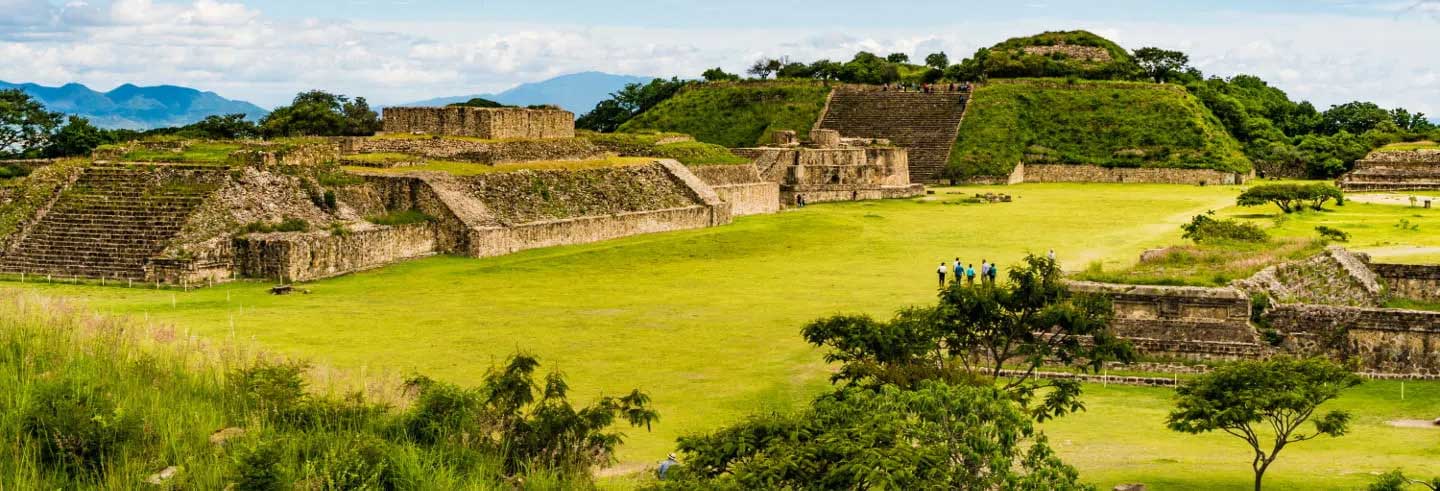
In the center of the Main Plaza is the building J and is undoubtedly one of the most interesting, because of its orientation and form, it is believed that the chamber to the rear was used for astronomic observations. The Palace is a structure with a central stairway and 13 chambers grouped around a central patio were used for priests and noble classes.
The System IV, a temple-patio-altar complex, also features the talud-tablero (slope-panel) architectural style similar to those found in Teotihuacán. Standing just north of System IV, is the tallest stelae (5.8 meters) in the site; is generally thought to have been used for astronomical and timekeeping functions, primarily the verification of midday and the dates of the solstices.
The Southern Platform is massive structure with a majestic staircase, 40 meters in width, ascends 15 meters in height to the platform itself (140 meters north-south by 108 meters east- west), atop there are two pyramidal temples; the northeast and southeast corners of the Platform contain carved stelae depicting zoomorphs figures and glyphs. The Monte Albán’s Tomb 7 was discovered in 1932 with one of the richest archaeological deposits of funerary ceramics, gold, and silver in the Americas; the burial offerings are exhibit at Museo Regional de Oaxaca.
Monte Albán’s site museum is very modern, attractive and well worth your visit, with an exhibit of stelae and some other objects found in the site; it has excellent interpretive displays. Restrooms, a small bookstore, and a cafe are also available here.
Route Coyotepec-Ocotlán
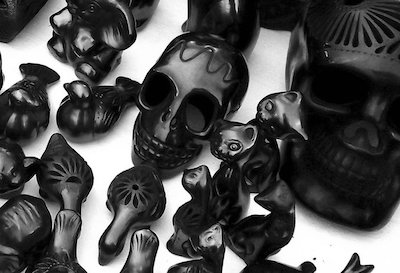
San Bartolo Coyotepec
The area was the settled homeland of the ancient Mesoamerican Zapotec civilization going back at least 2,500 years. The town is best known for its black clay pottery.
The polishing method had made the pottery far more popular and many pieces are produced now for decorative purposes, you can find real works of art.There is a nice church from the 16th century, The Pottery Museum and the State Museum of Popular Art of Oaxaca.
Santo Tomás Jalieza
It is known as the “town of belts” for the attractive embroidered cloth and leather belts that are made here. There is a single many-stalled market in the middle of town where you can buy the belts and some other attractive crafts like “huipiles”, purses, bags, and “rebosos”.
San Martín Ticajete
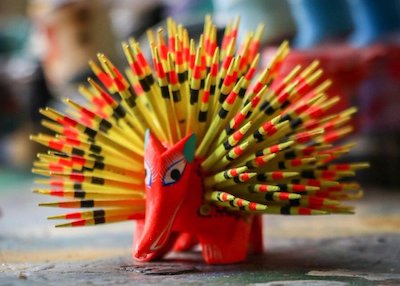
It is historically a Zapotec indigenous community, the first settlements date back to 1150 BC. The community is best known for its production of “alebrijes”, which are wood carvings of real or fantastic creatures painted in bright colors and intricate patterns. You can visit the Parish of San Martín, a nice colonial building. In April is held the Feria de Alebrije.
Ocotlán de Morelos
The town’s most important tradition is the weekly Friday market (tianguis), one of the oldest and largest in the Central Valleys region of Oaxaca where you can find many products like: food, ceramics, and of course the highest-quality mezcal. The city’s main attraction is the Temple and Ex-convent of Santo Domingo de Guzmán.
The complex was constructed in various stages between the 16th and 19th centuries. In both the church are a large number of colonial-era statues of saints, and the monastery was restored and converted into a museum that exhibits works by Morales (an internationally renowned artist), Oaxaca crafts, and artwork from the colonial period.
In the heat of the forge and in the midst of the rhythmic and incessant blow of the sledgehammer, it is how the artisans of Ocotlán turn coarse metal into beautiful and sharp blades, tempered by fire. Swords, knives, letter openers, daggers and sabers bear inscriptions of names or popular sayings, and their polished handles, made of leather, bone, bronze or horn, attest to the painstaking detail of this art, a centuries-old legacy of Toledo steels. traditionally used for the manufacture of swords and other weapons of war.
The Rodolfo Morales house, an 18th century mansion, has been transformed into a cultural center with some works of the artist and an open-air theatre. The municipal palace has a sober Neoclassic façade and in the interior there is a mural done by Rodolfo Morales.
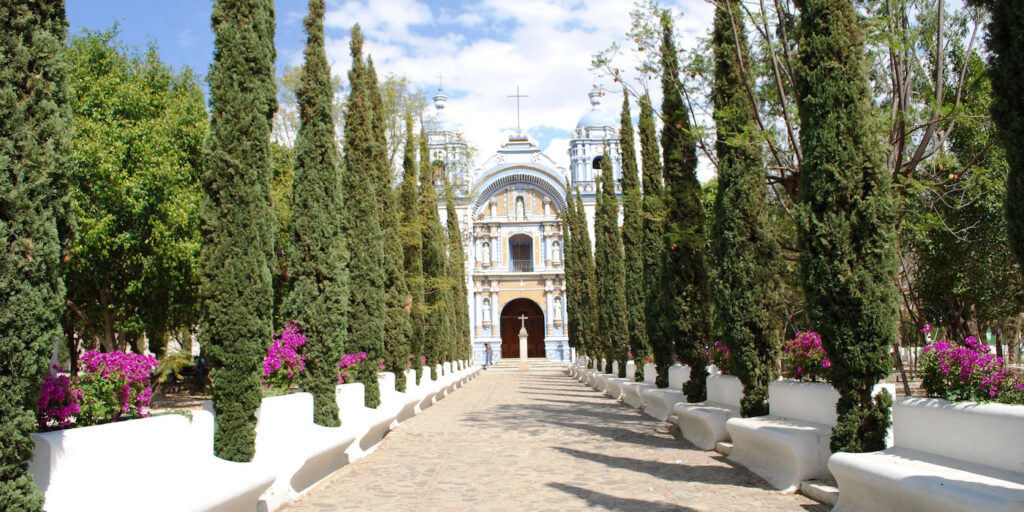
Route San Andres Huayapam - Capulalpam - Sierra Juarez
Ixtlán de Juárez
The village is surrounded by mountain landscape and is characterized by its architectural beauty. You may visit the Church of St Thomas the Apostle, a baroque building constructed 1640-1734. Ixtlán is now a center for eco-tourism. Its location, surrounded by cloud forest and pine gives it great natural landscape beauty.
Hiking trails link it to neighboring communities, and the Sierra Juárez Mountains are claimed to be home to around 500 bird species. The community produces interesting wooden handicrafts and pottery.
Sierra de Juárez
It is a range of mountains with an area of about 1,700 km2. The mountains climb from 500m to 3,250m, with many large and deep ravines. It is one of Oaxaca State’s wettest areas and richest in forest and fauna diversity. It has more than 400 species of birds, 350 and more than 6,000 plant species.
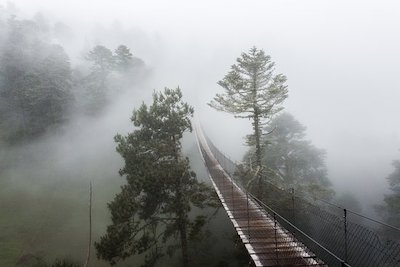
These beautiful and spectacular natural areas are excellent for activities such as hiking, mountain biking, horseback riding, wildlife watching, and canopy. In the area, there are centers offering traditional healing process like the ‘temazcal’ (indigenous steam bath) plant therapy, sobadas (massages) and herbal baths.
Here you can buy delicious preserved fruits like apple, hawthorn and peaches. There are several tours. In La Nevería there are tours to two natural viewpoints in bike or horseback riding. Llano Grande, is one of the cleanest communities in the country, ideal for mountain biking. Martha Latuvi, surrounded with spectacular scenery is a nice place for biking of horseback riding; the specialty is trout stuffed mushrooms.
One of the most enchanting hikes is along the 15km high-altitude footpath between the isolated villages of Latuvi and San Miguel Amatlán, which passes though mystical cloud forest and is believed to be part of a larger pre-Colombian route that connected the Zapotec cities. Santa Catarina Lachatao, is a heavily wooden area. Almost every community offers simple accommodation, local guides and places for camping.
San Andrés Huayapam
It is a picturesque town with peaceful environment, cobblestoned streets and beautiful landscapes of the mountains. The 16th century church built by Dominican priests is a hidden jewel with impressive paintings like “The Last Supper”, an incredibly beautiful altarpiece remarkable for the intricacy of its ornament, and a historic organ from the 18th century.
Huayapam is famous for the millennial drink called tejate. This pre-Hispanic drink is made out of cacao, corn and a flower called “cacao rose” (rosita de cacao). These are finely ground into a paste that is mixed with water. It is served cold with a touch of syrup in a colorful clay pot. The flor de cacao rises to the top to form pasty foam. Every year during Lent San Andres Huayapam hosts the Tejate Festival.
San Andrés Huayapam
It is a picturesque town with peaceful environment, cobblestoned streets and beautiful landscapes of the mountains. The 16th century church built by Dominican priests is a hidden jewel with impressive paintings like “The Last Supper”, an incredibly beautiful altarpiece remarkable for the intricacy of its ornament, and a historic organ from the 18th century.
Huayapam is famous for the millennial drink called tejate. This pre-Hispanic drink is made out of cacao, corn and a flower called “cacao rose” (rosita de cacao). These are finely ground into a paste that is mixed with water. It is served cold with a touch of syrup in a colorful clay pot. The flor de cacao rises to the top to form pasty foam. Every year during Lent San Andres Huayapam hosts the Tejate Festival.
Capulálpam de Méndez
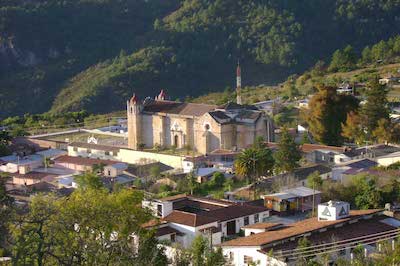
It was officially designated a “Pueblo Mágico” (magical town), it has been able to conserve, value and defend their historical-cultural heritage and manifest that in its gastronomy, handcrafts and music. You can stroll along the cobblestone streets lined with adobe and wood houses, as well as yellow quarry stone colonial constructions. The town has a beautiful 16th century church dedicated to St. Matthew, is particularly notable because the interior has 15 large, ornate, hand-carved altarpieces (retablos) from the 16th and 17th centuries.
Here you can find beautiful embroidered dresses, blouses, napkin and blankets. You can also visit the Art and Toys Gallery. There is Traditional Medicine Center with healers who provide medicinal plant therapy, massages, temazcal (a sweat lodge used to purify the body), ritual cleansings, and an herbal pharmacy that offers basic training courses about the medicinal plants. From 11 to 22 September, the town celebrates the annual fair in honor of St. Matthew the Apostle with the traditional calenda (a festive parade, usually with a band and people dancing), rodeos and fireworks.
Natural beauties surround Capulálpam so you can take pleasant walks or bike rides and admire the pine landscape, the colorful bromeliads and varieties of wild birds and diverse floral species of this beautiful forest area. There is a Management Unit for white tail deer, where the children can interact with this noble animals. In The Sabinos (The Cypress) you can rest under the shaded of these old trees. El Calvario (The Calvary), is lookout with a spectacular view of the town and the surroundings.
The Cueva del Arroyo (Cave of the Creek), with a multitude of capricious forms and figures. The Recreational Center Los Molinos (The Mills) with an exceptional 100 meters (330 ft.) zip-line suspended 30 meters (99 ft.) above the river. In the Cerro Pelado (Bald Hill) you can walk through a path or “Camino Real” (Royal Road) used in the colonial time to connect the different towns of the Northern Sierra.
Route Mixteca
San José Mogote
It was the largest and most important settlement in the Valley of Oaxaca during the period that goes from 500 to 500 BC. San José Mogote is possibly the oldest stone city in Mesoamerica. Trade with the Olmec culture is evident in the ceramic and stone pottery. The archaeological zone is composed of a square surrounded by many pyramidal platforms. There is a community museum in a restored hacienda, with an exhibit of interesting objects found in the site and the history of the hacienda.
San Juan Bautista Coixtlahuaca
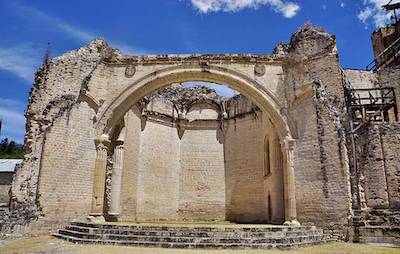
The Renaissance-style Templo y Ex-Convento de San Juan Bautista is a wonderful complex built by the Dominicans in 1576. It includes the open chapel, the temple, the cloister and a churchyard. The interior of the sanctuary is perhaps the best preserved of the Dominican churches in the region. The church’s patron saint stands guard over the intricately carved altarpiece. The graceful open chapel bears Mixtec religious symbols like serpents and eagles.
San Pedro y San Pablo Teposcolula
The Dominicans were established here in 1541, and founded a convent in 1538. The complex includes the open chapel, the temple, and the convent house or cloister, and is one of most impressive in the region. The meticulously restored open chapel, also called the Indigenous Chapel, is the pride of Teposcolula, is remarkable for the design of its spaces. The roof resembles the vaulted ceiling inside the sanctuary, but between the ribs it’s open to the sky and the underside is studded with gleaming gold medallions. In the temple you will find some beautiful paintings by Andrés de la Concha and Andrés Pereyns.
The monastery is a small museum with a pleasant rose garden ringed by small rooms and few restored monks’ cells. The sprawling churchyard was built for the evangelization of thousands of Mixtecos. The other interesting structure in Teposcolula is the Casa de la Cacica, (House of the Priestess); the Spanish built this stone building for a Mixteca leader and is a perfect combination of pre-Hispanic and colonial architecture; today has been restore and is a public library. Not far from Teposcolula is the archaeological site of Pueblo Viejo (Yucundaa) on a mountain ridge. This site flourished between 1000 and 1550 AD.
Santo Domingo Yanhuitlán

During the colonial era it was an important trade center. The magnificent 16th-century Templo y Ex Convento de Santo Domingo de Guzmán and its adjoining monastery sit on a hill overlooking the village. It was built atop an old Mixtec religious site. The sheer size of the structure is one of its stunning features; its vaulted ceiling soars to almost 25 meters (82 feet). The gold- leaf Baroque altarpiece, behind the main altar, has five levels, each depicting various saints and some paintings by the Spanish master Andrés de la Concha. Don’t miss the Mudejar (Moorish) designs suspended beneath the choir loft and the impressive 18th- century pipe organ. The Regional Museum of the Ex Convento de Santo Domingo Yanhuitlán features an interesting exhibition of religious art and the facsimile of the codex Yanhuitlán. Open Tuesday to Sunday from 9:00 to 17:00 hrs.
Villa de Etla
Here is the curch and former monastery of San Pedro y San Pablo. The complex was completed in 1636 and consists of three parts, atrium, temple and monastery.
Tlaxiaco
This picturesque town has the Nuestra Señora de la Asunción Church built in 1548. The construction is a classic statement of the Dominican high style and similar to the one in Yanhuitlán. The church offers a sober and well- balanced façade but the interior is especially elegant, with a five-tier chandelier hanging from the dome. The main square has a nice clock and the weekly market draws people in from a broad, highland region.
Mezcal Route
The word mezcal comes from Nahuatl metl and ixcalli which mean ‘oven cooked agave. It is a distilled alcoholic beverage made from the maguey plant. Traditionally, mezcal is handcrafted by small-scale producers in Oaxaca, and is still made from the heart of the maguey plant, called the “piña,” much the same way it was 200 years ago, in most places.
Mezcal is highly varied, depending on the species of agave or maguey used, the fruits and herbs added during fermentation and the distillation process employed, creating sub-types with names such as de gusano, tobalá, pechuga, blanco, minero, cedrón, de alacran, among others.
There are also creams of mezcal, a product of a double distillation of the agave which joins the mezcal slow with a select fruit, a very unique combination of flavors, for example with coffee, maracuya, mango, coconut, strawberry, piña colada, capuccino, passion fruit, just to mention some.
Mezcal Route includes the Southern Highlands, a mountainous region, with forest landscapes with. This is an important coffee- growing region.
Santiago Matatlán
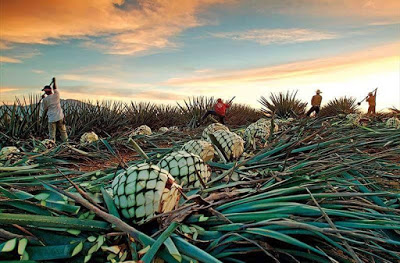
It is one of most important mezcal producers in the state. There are a number of mezcal factories and stands. It is known as the “World Capital Of Mezcal”. You can also visit the church of St. James built in the 17th century, with two bell towers. Heading north of Matatlán, there is an archeological zone, but it hasn’t been explored yet. Here is held the Annual Fair of Mezcal.
Tlacolula
The picturesque town feature one of the most beautiful chapels in Oaxaca. The Church of La Asunción de Nuestra Señora was completed in the 16th century. It is also famous its Sunday open-air market with an almost ritual and mystical atmosphere. Tlacolula is famous also for its excellent bread, exquisite mezcal and its tasty barbecue.
Yautepec
In addition to sample the mezcal of the region, you can also acquire some of its beautiful textiles, pottery clay and the various crafts of palm.
Sola de Vega
Also famous for its mezcal, the population also produces beautiful embroidered blouses and different pieces of pottery.
Ocotlán
The city’s main attraction is the Templo y Ex–convento de Santo Domingo de Guzmán. The church is fronted by a very large atrium fenced by a stonewall. The main facade has two bodies and a crest with both Baroque and Neoclassical styles. There are also Neoclassical elements inside the temple. Other attractions are: the City Hall built in 1913 and a community museum located in the former convent of the Dominicans.
Salina Blanca
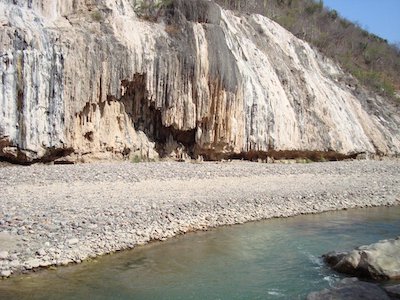
Its name comes from the fact that around the region there are salt formations. The cliff present white rock formations which look like waterfalls, this is a unique view from the banks of the Quiechapa river.
Eighty miles downstream from here there some fresh water springs, whose water is over saturated with minerals; as the water runs down the slope, the excess minerals are deposited. All the area is an excellent option for camping, hiking and for nature lovers.
Ejutla
Among the most important buildings in the town are the Templo de Santa María de la Natividad, with impressive altarpieces. You can also visit the picturesque arcades surrounding the town “Zocalo”.
Miahuatlán
Here you can visit the parish church, the pillar, the municipal palace, the archaeological zone, the Yoolveo ravine, the Loma de los Nogales (walnut trees hill), and the central garden.
Zimatlán
This is one of many Zapotec towns of the area. It has been inhabited since the era of Monte Albán. It is famous for its production of mezcal.
More Tourist Attractions in OAXACA
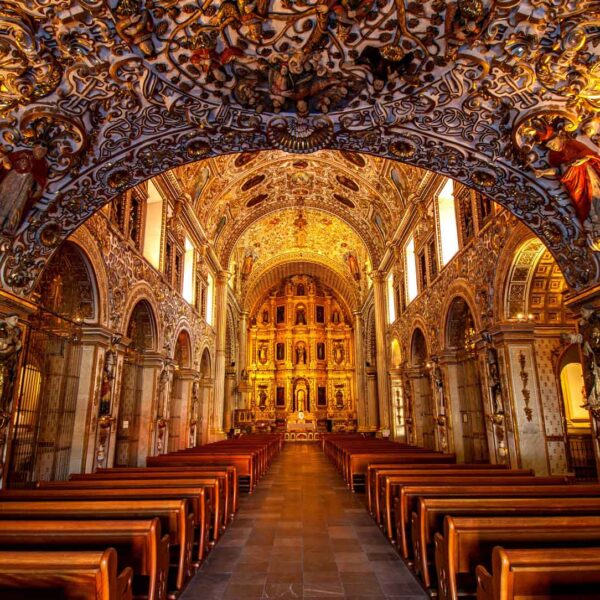
Santo Domingo Cultural Center
The Santo Domingo Cultural Center is a cultural complex that is located in what was one of the most important convents in the colony. It is a large convent in which the Museum of the Cultures of Oaxaca, the Fray Francisco de Burgoa Library and the Ethnobotanical Garden have been established. The Néstor Sánchez Public Newspaper Library is located in a building that is part of the complex but dates from the 19th century.… Read More
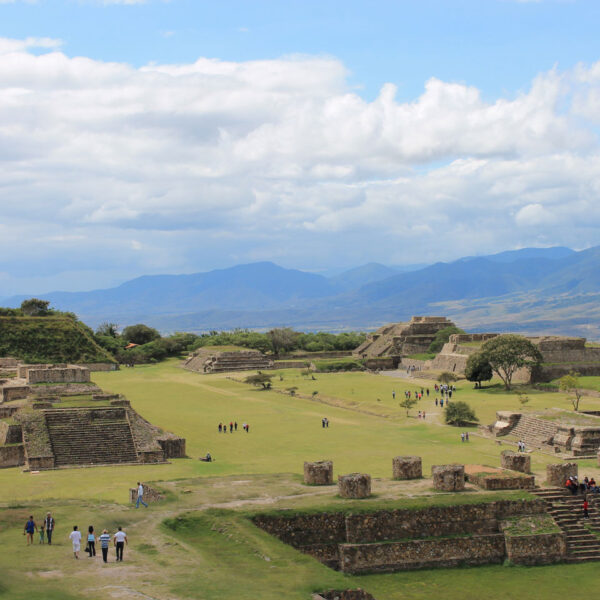
Monte Alban
Monte Alban is the most important archaeological zone of the Oaxacan entity, of unique regional importance due to the religious, political and economic control that the Zapotec state exercised over the population of the Valley of Oaxaca for more than thirteen centuries. It has been named by UNESCO Cultural Heritage of Humanity together with the city of Oaxaca on December 11, 1987. The heritage of the Zapotec world reaches us through the magnificent archaeological sites designed in the Valley of Oaxaca. Of these, the city of Monte Albán stands out for its enormous importance as an economic, political and religious hub (it was the first urban complex in Mesoamerica); by its extension, almost as big as the current capital of Oaxaca; and for its long life, started around 500 BC and concluded around 850 AD.… Read More
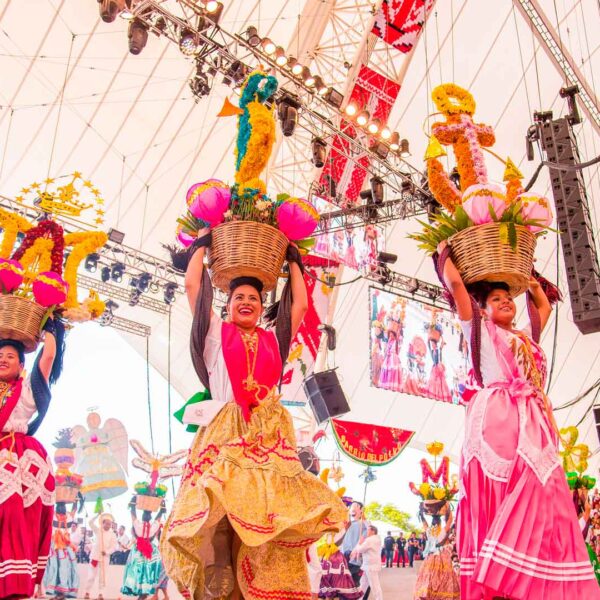
La Guelaguetza
The Guelaguetza is an ancient tradition with pre-Hispanic roots related to agricultural ceremonies of gratitude to the gods for the arrival of the rains and the lifting of the harvest at the end of July and is the largest festival in Oaxaca. La Guelaguetza is a celebration of gratitude for the arrival of the rains and the harvests, in which representatives from all regions of the state gather in the capital to share their culture through dances, crafts and food. La Guelaguetza is celebrated every year on the two Mondays after July 16, except when the first Monday is July 18, Benito Juárez’s death anniversary. Many types of dances also participate, such as the traditional Flor de Piña; where women usually dress in Huipiles representing the different regions of the state, as well as with their pineapple on their shoulders, they comb their hair with beautiful long braids accompanied by their ribbons and can not missing her accessories that is, bracelets, necklaces and earrings of precious colors and her beautiful makeup.… Read More

Mezcal
Mezcal is a rich, handcrafted flavored drink that requires considerable attention to be produced. Mezcal is normally served with white salt or worm salt (salt mixed with a cooked larva and ground chili), lemon or orange. Mezcal production today remains more or less as it was when the Spanish arrived hundreds of years ago. Each “recipe” is transmitted from generation to generation within the families that care about its production; Because each family has its own approach to mezcal production, there are an enormous number of different flavors. It is also in this way that the rich diversity of flavors and traditions are preserved for all to enjoy.… Read More
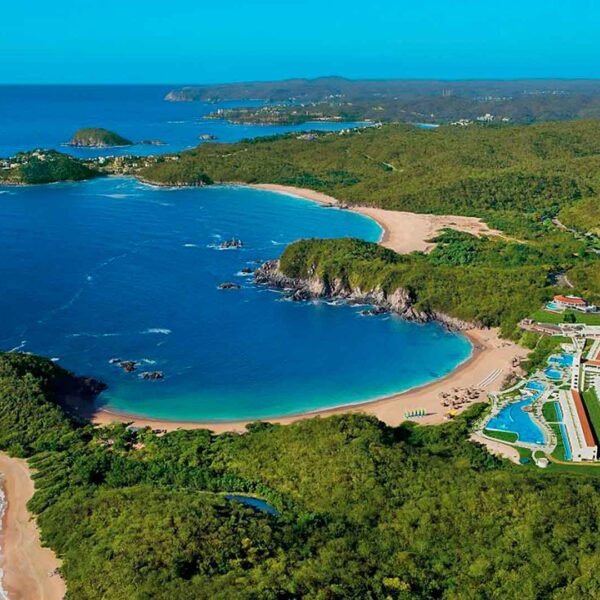
Beaches in Oaxaca
The beaches of the coast of the state of Oaxaca are among the most beautiful and complete in Mexico, thanks to a developing tourist infrastructure and the rich gastronomy of the Pacific. Along the 533 kilometers of coastline, the beaches of Oaxaca offer a wide variety of activities for lovers of water sports: snorkeling, diving, sport fishing, surfing, among others… there is something for everyone!… Read More
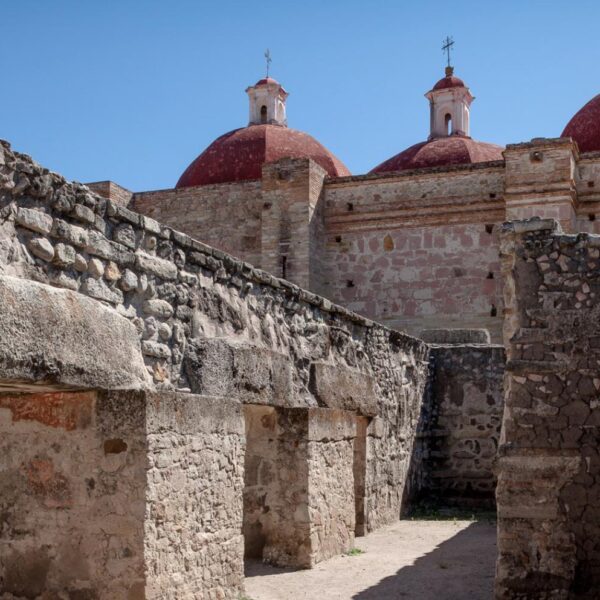
Archaeological Sites in Oaxaca
Oaxaca is famous throughout the world for its archaeological sites and the history they keep. Discover Monte Alban, Mitla, Yagul and more of these remote sites, which have made Oaxaca a World Heritage city, according to Unesco. The original Zapotec and Mixtec peoples of Oaxaca lived in the cities and religious centers of the valley of this city until the time of Spanish colonization. Today, there are still vestiges of these towns and places where you can meet them.… Read More
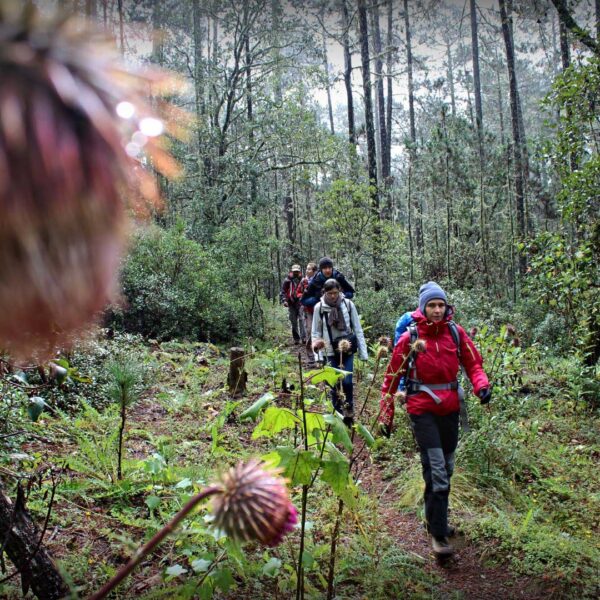
Ecotourism and Adventure in Oaxaca
Oaxaca, located in the southeast of Mexico, is an example of a singular miscegenation that even in the midst of modernity never forgets its origins. In its varied geography, it brings together not only a vast biodiversity, considered among the largest in the world, but also insurmountable cultural and ethnic riches, and the most different and beautiful natural settings. An ideal space for Alternative Tourism, Oaxaca offers activities such as walking, mountain biking, rappelling, climbing, zip-lining, horseback riding, observation of flora and fauna and more, in close contact with nature. The visitor can also witness the various aspects of local life, savor the gastronomy and enjoy the warmth of its people, as well as an offer of accommodation in hotels, ecotourism cabins, local houses or excellent camping areas.… Read More
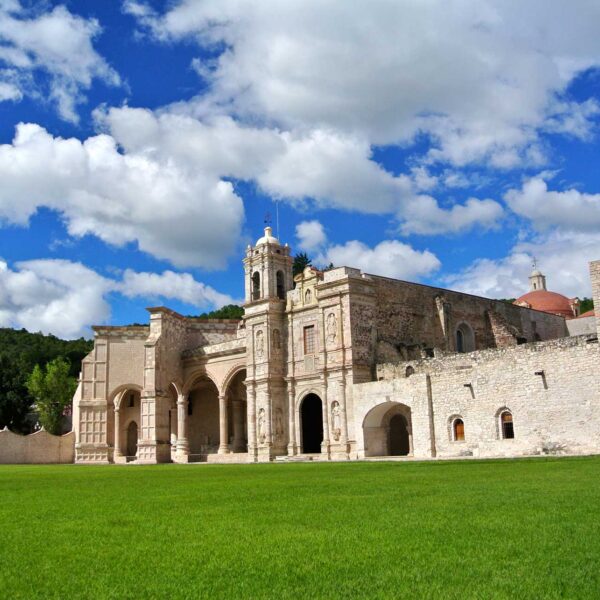
Magical Towns in Oaxaca
In Oaxaca we are proud to have 5 communities that have been awarded the title of Magical Towns of Mexico, a Magical Town is a town that has symbolic attributes, legends, history, transcendent events, everyday life, in short magic that they emanate in each of their socio-cultural manifestations, and that today mean a great opportunity for tourist use. The Magic Towns Program contributes to revalue a group of populations in the country that have always been in the collective imagination of the nation as a whole and that represent fresh and different alternatives for national and foreign visitors.… Read More
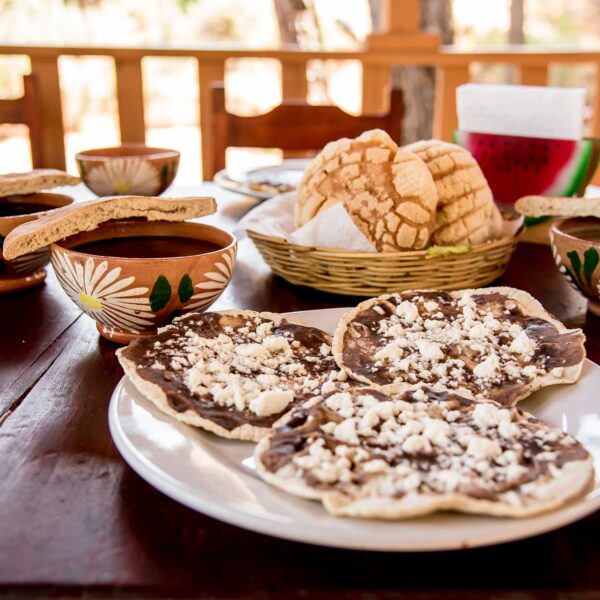
Gastronomy of Oaxaca
The Oaxacan gastronomy takes you on an amazing journey into one of the most outstanding and colorful cuisines in the world. Oaxacan food is among the most varied and delicious in Mexico, UNESCO has declared it Humanity’s Cultural Patrimony. Oaxaca’s gastronomy incorporates elements of pre-Hispanic cuisine, and lively imagination has created combinations that amaze by the color, the aromas and the flavors.
The list of dishes that characterize this cuisine is endless, however, we can mention: Oaxacan Mole in its 7 varieties depending on the type of chili used, Chapulines, (dry roasted, spiced grasshoppers), tlayudas (large tortilla spread with the remaining of the lard and beans), maguey worm sauce, chiles rellenos (stuffed chilies), and of course the famous Oaxacan tamales in banana leaves. Oaxaca cheese is a soft white string cheese, which is similar to mozzarella. It is sold in “ropes” which are wound onto themselves into balls, and eaten cold or lightly melted on quesadillas is considered among the best in the world.… Read More
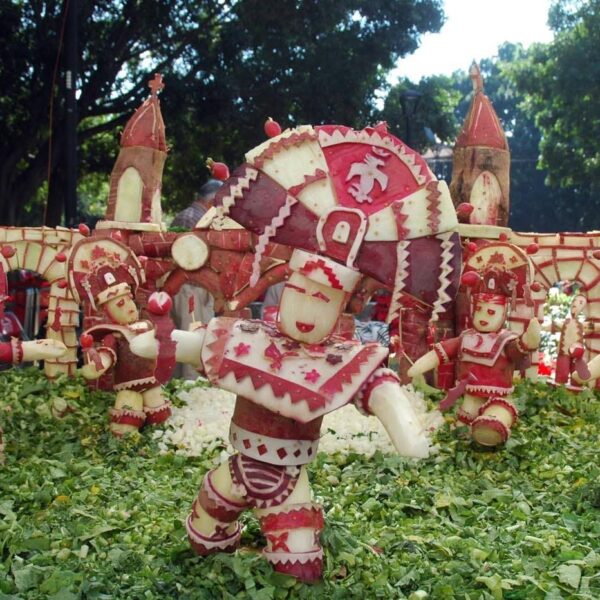
Traditions of Oaxaca
In the state of Oaxaca there are many customs and traditions throughout the year, and within the state, said that they have the same purpose of celebration but with different things, in fact from one region to another or even more from one town to another, the Customs vary for perhaps details but that is what makes them authentic. All the holidays are celebrated, the profane and the religious ones. The festival calendar is extensive due to the diversity of ethnic groups, which they still conserve. Oaxaca has a combination in its traditions of the culture of the ancestors and the current culture, a state that does not lose its customs, adapts them to new times and needs.… Read More
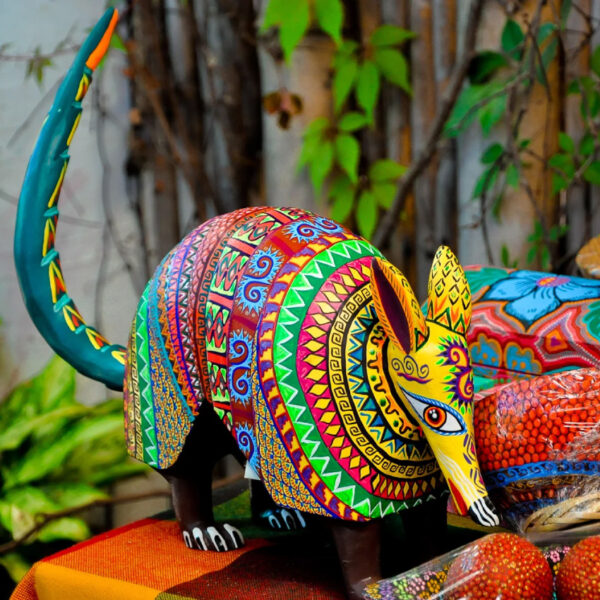
Handicrafts from Oaxaca
Handicrafts from Oaxaca are a great tradition and they offer a diversity that denotes the artistic richness and imagination of its people. The talented artisans of Oaxaca make beautiful pieces of clay, textiles, wood, metal, skins and other materials, forming a rich and varied folk art in both decorative and useful items.… Read More
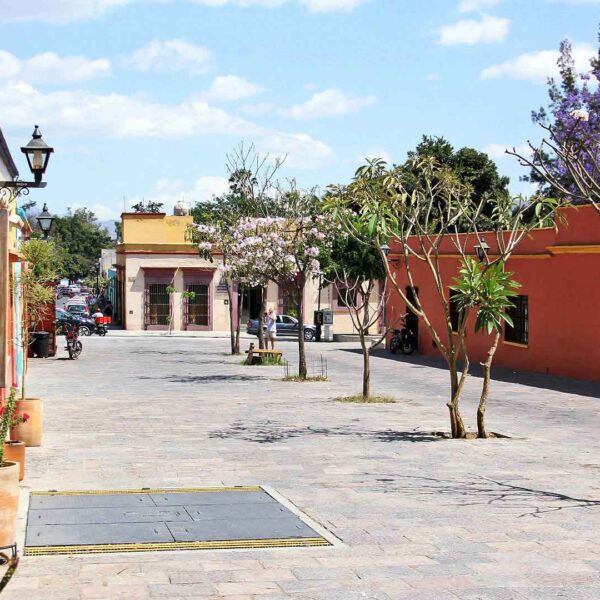
Oaxaca City
Oaxaca is the most diverse state in Mexico. It has peaks that reach more than 3,000 meters high, caverns that are among the deepest in the world, virgin beaches, secluded forests, and sunlit valleys. Oaxaca is rich in traditions and customs and has the largest ethnic population found in Mexico.
The City of Oaxaca, the state capital, is famous for its architecture and for its rich cultural traditions. Oaxaca is also graced by a splendid and varied cuisine and spring-like weather year round. UNESCO declared the city a Cultural Heritage Site.… Read More
Guided Tours in OAXACA
Flights & Hotels in OAXACA
More Tourist Attractions in MEXICO

Capital Cities
Folklore, gastronomy, literary culture, art and exhibitions, is what you will find in the capitals of the states of Mexico. To the north, colonial Mexico, Puebla, Guadalajara, Guanajuato, the Sonoran desert and the California peninsula. To the east Veracruz and the gulf. To the west Acapulco, Oaxaca and Tuxtla Gutiérrez. And to the south the Riviera Maya and the pyramids of Chichén-Itzá, Tulúm and Cobá in Yucatán, Palenque in Chiapas, the cenotes, and the Central American jungles.… Read More

Archaeological Sites
The Archaeological Zones are the cultural past of every Mexican. You will be amazed at the ambient, nature and the environment that surrounds them. Climbing to the top or being around it will take us back in time to admire every detail. México is a country of culture and traditions, many of which we have inherited from the pre-Hispanic inhabitants of this vast territory, although it is true that there were more settlements in the central and southern part of the country, it is also possible to find some archaeological remains in the north.
… Read More

Magical Towns
A Magical Town is a place with symbols and legends, towns with history that in many cases have been the scene of transcendent events for our country, they are places that show the national identity in each of its corners, with a magic that emanates from its attractions ; visiting them is an opportunity to discover the charm of Mexico. The Magical Towns Program contributes to revalue a set of populations in the country that have always been in the collective imagination of the nation and that represent fresh and varied alternatives for national and foreign visitors. A town that through time and in the face of modernity, has conserved, valued and defended its historical, cultural and natural heritage; and manifests it in various expressions through its tangible and intangible heritage. A Magical Town is a town that has unique, symbolic attributes, authentic stories, transcendent events, everyday life, which means a great opportunity for tourist use, taking into account the motivations and needs of travelers.… Read More

Ecotourism and Adventure
Mexico is one of the best countries for Ecotourism as it has a great variety of flora and fauna, as well as a large number of refuges for extraordinary species. You can enjoy recreational activities of appreciation and knowledge of nature through contact with it, such as: stargazing, observation of natural attractions, wildlife and bird watching. Throughout México there are more than 176 protected natural areas, 5 of them considered by UNESCO as Natural Heritage of Humanity. Just for this and much more, we believe that Mexico is a Paradise for Ecotourism.… Read More

Beaches
On the Beaches of Mexico you can immerse yourself in the intense blue ocean of the Pacific bays, sunbathe on the shore of the warm and transparent waves of the Caribbean Sea in Quintana Roo or even rest on the beautiful coasts of the Gulf of Mexico. Mexican beaches hide wonderful secrets for the traveler. By visiting them, in addition to enjoying the excellent climate and water activities, you can discover splendid archaeological sites and interesting colonial cities without traveling long distances.… Read More

Traditions in Mexico
It is practically impossible to make a meticulous, and above all, accurate selection of the places to visit in Mexico. Each place that our country houses is unique and beautiful in its own way. Mexico, with its nearly 2 million km², has a large number of scenarios to offer, as well as endless activities to do. Do not lose your way and enter the places to visit in Mexico. In Mexico, apart from the beaches and its famous archaeological sites, there are many other really interesting sites and activities that you should know. In the surroundings of the main cities you will find places full of culture and tradition, where you can spend relaxing, interesting and fun vacations. On your trip through Mexico you cannot stop obtaining souvenirs, the crafts that are made here are of the highest quality and recognized worldwide. A shopping tour cannot be missed.… Read More

Gastronomy
The Gastronomy of Mexico has a great diversity of typical dishes, which is why it was recognized by UNESCO as Intangible Heritage of Humanity. The basic and representative ingredients of Mexican dishes are: corn, coriander, chili, beans, piloncillo, nopal and tomato. Mexican cuisine is also characterized by its sauces, which serve as an accompaniment to traditional dishes, prepared based on spices.… Read More

States Of Mexico
Mexico has an incredible diversity of landscapes, where the beauty of its beaches, internationally recognized, stands out. In its vast territory of coasts, there are beaches of unparalleled beauty, and colorful landscapes. A large network of first-class hotels and tourist services is available to visitors to these beaches. Mexico is also mystical places, dotted with archaeological testimonies inherited from its original inhabitants. Monuments made by the Mayas, Aztecs and Toltecs are located in magical landscapes, like lighthouses in an ocean of natural beauty. They offer visitors buildings that tell their history, and museums that collect their cultural heritage. And that keep alive ancestral traditions, in ceremonies and festivals, where you can enjoy cultural activities and entertainment.… Read More

